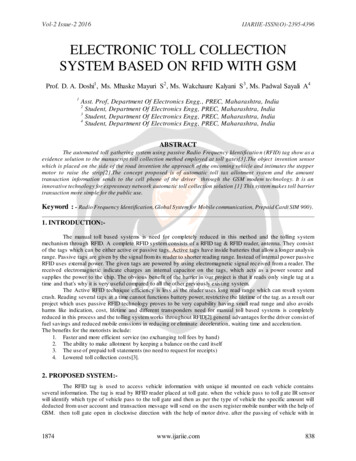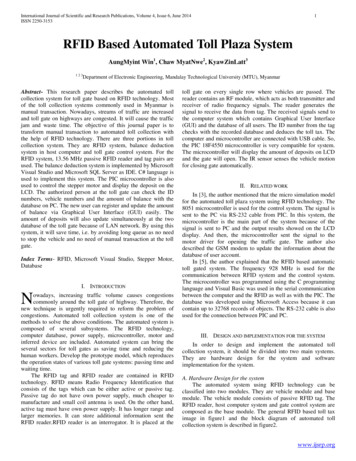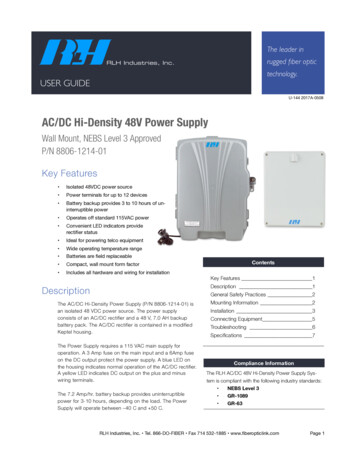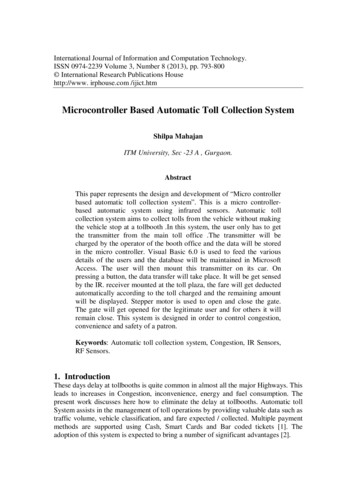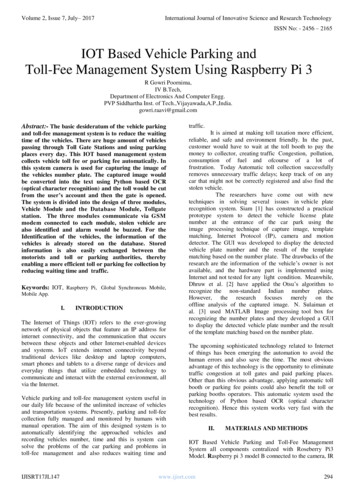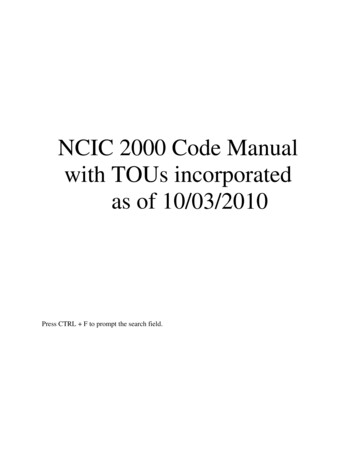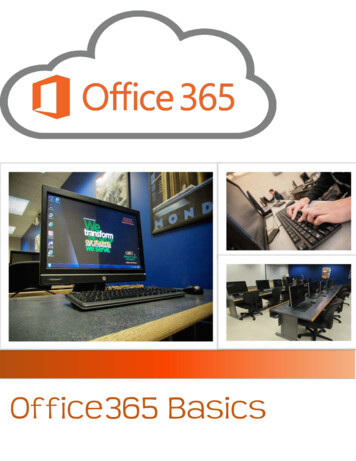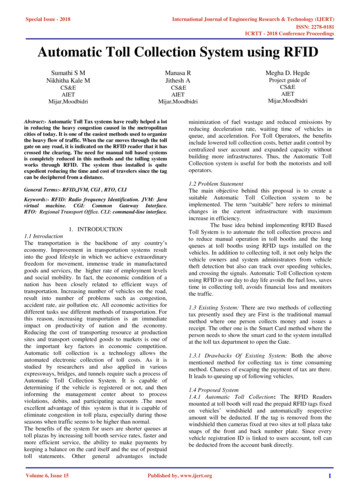
Transcription
Special Issue - 2018International Journal of Engineering Research & Technology (IJERT)ISSN: 2278-0181ICRTT - 2018 Conference ProceedingsAutomatic Toll Collection System using RFIDSumathi S MNikhitha Kale MManasa RJithesh tract:- Automatic Toll Tax systems have really helped a lotin reducing the heavy congestion caused in the metropolitancities of today. It is one of the easiest methods used to organizethe heavy flow of traffic. When the car moves through the tollgate on any road, it is indicated on the RFID reader that it hascrossed the clearing. The need for manual toll based systemsis completely reduced in this methods and the tolling systemworks through RFID. The system thus installed is quiteexpedient reducing the time and cost of travelers since the tagcan be deciphered from a distance.General Terms:- RFID,JVM, CGI , RTO, CLIKeywords:- RFID: Radio frequency Identification. JVM: Javavirtual machine. CGI: Common Gateway Interface.RTO: Regional Transport Office. CLI: command-line interface.1. INTRODUCTION1.1 IntroductionThe transportation is the backbone of any country’seconomy. Improvement in transportation systems resultinto the good lifestyle in which we achieve extraordinaryfreedom for movement, immense trade in manufacturedgoods and services, the higher rate of employment levelsand social mobility. In fact, the economic condition of anation has been closely related to efficient ways oftransportation. Increasing number of vehicles on the road,result into number of problems such as congestion,accident rate, air pollution etc. All economic activities fordifferent tasks use different methods of transportation. Forthis reason, increasing transportation is an immediateimpact on productivity of nation and the economy.Reducing the cost of transporting resource at productionsites and transport completed goods to markets is one ofthe important key factors in economic competition.Automatic toll collection is a technology allows theautomated electronic collection of toll costs. As it isstudied by researchers and also applied in variousexpressways, bridges, and tunnels require such a process ofAutomatic Toll Collection System. It is capable ofdetermining if the vehicle is registered or not, and theninforming the management center about to processviolations, debits, and participating accounts .The mostexcellent advantage of this system is that it is capable ofeliminate congestion in toll plaza, especially during thoseseasons when traffic seems to be higher than normal.The benefits of the system for users are shorter queues attoll plazas by increasing toll booth service rates, faster andmore efficient service, the ability to make payments bykeeping a balance on the card itself and the use of postpaidtoll statements. Other general advantages includeVolume 6, Issue 15Megha D. HegdeProject guide ofCS&EAIETMijar,Moodbidriminimization of fuel wastage and reduced emissions byreducing deceleration rate, waiting time of vehicles inqueue, and acceleration. For Toll Operators, the benefitsinclude lowered toll collection costs, better audit control bycentralized user account and expanded capacity withoutbuilding more infrastructures. Thus, the Automatic TollCollection system is useful for both the motorists and tolloperators.1.2 Problem StatementThe main objective behind this proposal is to create asuitable Automatic Toll Collection system to beimplemented. The term “suitable” here refers to minimalchanges in the current infrastructure with maximumincrease in efficiency.The base idea behind implementing RFID BasedToll System is to automate the toll collection process andto reduce manual operation in toll booths and the longqueues at toll booths using RFID tags installed on thevehicles. In addition to collecting toll, it not only helps thevehicle owners and system administrators from vehicletheft detection but also can track over speeding vehicles,and crossing the signals. Automatic Toll Collection systemusing RFID in our day to day life avoids the fuel loss, savestime in collecting toll, avoids financial loss and monitorsthe traffic.1.3 Existing System: There are two methods of collectingtax presently used they are First is the traditional manualmethod where one person collects money and issues areceipt. The other one is the Smart Card method where theperson needs to show the smart card to the system installedat the toll tax department to open the Gate.1.3.1 Drawbacks Of Existing System: Both the abovementioned method for collecting tax is time consumingmethod. Chances of escaping the payment of tax are there.It leads to queuing up of following vehicles.1.4 Proposed System1.4.1 Automatic Toll Collection: The RFID Readersmounted at toll booth will read the prepaid RFID tags fixedon vehicles’ windshield and automatically respectiveamount will be deducted. If the tag is removed from thewindshield then cameras fixed at two sites at toll plaza takesnaps of the front and back number plate. Since everyvehicle registration ID is linked to users account, toll canbe deducted from the account bank directly.Published by, www.ijert.org1
Special Issue - 2018International Journal of Engineering Research & Technology (IJERT)ISSN: 2278-0181ICRTT - 2018 Conference Proceedings1.4.2 Vehicle Theft Detection: When vehicle is stolen theowner registers complaint on the website with itsregistration ID and unique RFID tag number. Now whenstolen vehicle passes by the toll plaza, the tag fixed on it ismatched with the stolen vehicle's tag in the database at thetoll booth. . Automatic collection of toll tax. Free flow of traffic. Time saving. Record maintenance. Problems with pursuing toll evaders. Avoid the fuel loss. Avoid financial loss. Higher efficiency in toll collection. Cheaper cost. Smaller in size compared with the existing system. Durable tags.2.LITERATURE SURVEYThe Toll Collection System has changed drastically overthe years; from being a single borderline, a small passagebooth to the huge toll collection infrastructure that has akey role in the revenue generation as well as the working ofthe traffic of a city or even a state. While the majority ofthe population is travelling vs different means it hasbecome a necessity and regulatory method to controltraffic.Sachin Bhosale et.al discuss about RFIDtechnology for automating the process of tollbooth system.RFID stands for Radio Frequency Identification. Thecomponents of the RFID System basically include RFIDtransmitter, a RFID receiver and some processing machine.The paper then goes on to discuss about the types of RFIDtags. Types of RFID tags include Active Tags and PassiveTags. An active RFID tag is equipped with a battery. It canbe used as a source of power for the tag's circuitry. It hasbetter identification range and larger capacity. Active tag isable to send a strong signal to the reader because of thepresence of battery. The major advantages of an activeRFID tag are that they allow a read range of about onehundred feet and hence providing a high sensing range. Itallows other sensors that can use electricity for power.Then goes on to discuss about the components ofthe toll collection system. An RFID reader is a device usedto communicate with an RFID tag. The reader has anantenna which emits radio waves. The tag responds bysending back its data. The GSM module is used forconnecting the entire system through the Internet. Whenthe vehicle passes through the tollgate the LCD systemdisplays the information about that vehicle. The MotorDrive controls the gate of the system. IR sensor is used todetect the presence of the vehicle. The alarm indicatorindicates the illegal passing of vehicles through thetollgate. Then the paper describes the working of thesystem. When vehicle cross the sensor which are fixed atsome meter distance from the tollbooth, Tag will read byRFID Reader. TAG houses unique identification number.The data read by the RFID reader will be send toMicrocontroller (8051). Then the microcontroller willVolume 6, Issue 15process the data for authentication. If the user is valid, thendata will send to processing unit. It then checks the accountof that user from database. If sufficient amount, then user isallowed to pass. If amount is not sufficient to pay toll, thenuser must have to pay the toll manually. The system hassome disadvantages because of the use of active tag.The problems of an active RFID tag are that the tag cannotfunction without battery power, which cause reducedlifetime of the tag. On the other hand, the tag is typicallymore expensive. The tag is physically larger, which maylimit applications.So in the proposed system, the passive tags areused to overcome from these disadvantages. A passive tagis an RFID tag that does not contain a battery. The power issupplied by the reader. The main advantage of a passive tagis that the tag functions without a battery. Passive tags havea useful life of twenty years or more. The tag is typicallymuch less expensive and smaller.Asif Ali Laghari et.al discusses another systemwhich solve the problem of waiting period and paymentissues in the conventional manual toll collection system.This proposes a system which contains transponder,Antenna, Traffic Controller System & Central Server.Transponder is the RFID tag which houses a uniqueidentification number. The Traffic Controller Systemmakes the system different from others. This systemmanages the distribution of vehicles incoming across a setof parallel toll gates. It uses a Lane Allocation Algorithm.This algorithm allocates the cars approaching the toll gateamong the set of the toll gates. The system also employstraffic speed controller. Once the RFID tag comes into therange of the Toll Plaza, the ECU (Electronic ComputerUnit) is directed to reduce the speed of the vehicle. Theproblem with the system is that, once the algorithm failsthe entire system fails and leads to huge traffic overhead.Abhishek Sharma et.al.is also based on RFID. Inaddition to that it uses load sensing technology. It firstdiscusses about the operation of RFID. As discussed in theprevious paper, the proposed RFID system uses tags thatare mounted on the windshields of vehicles, through whichinformation on the tags are read by RFID readers. In eachautomated toll booth, there will be a RFID sensor and aload sensor. Control booth will house a computer and anoperator. Then discussed each operation step by step. Firststep is reading the card. RFID works in radio frequency.When a vehicle with TAG approaches a toll booth theRFID sensor detects it. Then it sends the detected tag id tothe server through MAX232 serial communication.3. SYSTEM REQUIREMENT SPECIFICATION3.1 Hardware Requirements CPU type: Intel Pentium 4Clock speed: 3.0 GHzRam size: 512 MBHard disk capacity: 40 GBMonitor type: 15 Inch color monitorKeyboard type: Internet KeyboardMobile: Android MobileEM 18RIFD Reader modulePublished by, www.ijert.org2
Special Issue - 2018 International Journal of Engineering Research & Technology (IJERT)ISSN: 2278-0181ICRTT - 2018 Conference ProceedingsATmega328ESP8266 WiFi ModuleRIFID TAG3.2 Software RequirementsSoftwareOperating System:Language:IDE:WeaverWeb ServerDatabase:Java Version:DescriptionWindowsJava, XML, PHP, HTML,CSSAndroid Studio, Dream:eu5My SQLJDK 1.84.SYSTEM DESIGN4.1 System Development MethodologyThe basic methodology for the project is designed so thatthe system can be available to everyone who needs it andcan be installed anywhere by anyone. The principle of theproject is RFID i.e. Radio Frequency Identification is usedto find which vehicle has reached the toll and using its prefed information to carry out further functions like allowingthe vehicle to pass or not. The system is mostly dependenton microcontroller i.e. ATmega328 embedded onARDUINO board. The owner of the vehicle has a RFIDtag, which is read by the RFID reader. On reading the tag,the tag ID obtained is sent to microcontroller after which itanalyses the tag ID and matches it with the IDs saved in thedatabase, and further actions will be taken based on thestatus of the tag.Figure 4.1: Block diagram of RFID based automatic tollcollection al328Serial(Arduino)CommunicationWi-FiModuleDC Motor(Gate)Volume 6, Issue 15SERVERThe RFID based Toll Collection System basically consistsof following main blocks, RFID Tag: An RFID tag, or transponder, consistsof a chip and an antenna. A chip can store aunique serial number or other information basedon the tag’s type of memory, which can be readonly, read-write, or write once readmany(WORM). The antenna, which is attached tothe microchip, transmits information from the chipto the reader. Typically, a larger antenna indicatesa longer read range. The tag is attached to orembedded in an object to be identified, such as aproduct, case, or pallet, and can be scanned bymobile or stationary readers. RFID Reader: In order for an RFID system tofunction, it needs a reader, or scanning device,that is capable of reliably reading the tags andcommunicating the results to a database. A readeruses its own antenna to communicate with the tag.When a reader broadcasts radio waves, all tagsdesignated to respond to that frequency and withinrange will respond. A reader also has thecapability to communicate with the tag without adirect line of sight, depending on the radiofrequency and the type of tag (active, passive, orsemi passive) used. Readers can process multipleitems at once, allowing for increased readprocessing times. They can be mobile, such ashandheld devices that scan objects like pallets andcases, or stationary, such as point-of-sale devicesused in supermarkets. ArduinoBoardwithATmega328Microcontroller: The ARDUINO is an electronicmultipurpose board based on ATmega 328microcontroller. It has 6 Analog input pins and 14digital IO pins, out of these 14 pins 6 can be usedas PMW outputs as well. It contains lot ofcomponents. It already has all the thingsembedded in it which are needed for properworking of the microcontroller. It can be directlyconnected to the computer through USB cable orcan be used either by giving power throughAC/DC adaptor.The ATmega328 is a unity chip microcontrollermanufactured by “Atmel” in its megaAVR chipfamily. This microcontroller is usually used inprojects and automated systems in which cheap. ESP8266 WiFi Module: The ESP8266 is a verycheap yet really effective platform forcommunicating over the internet. It is also easy touse with an Arduino. It helps the admin to controlthe hardware through the internet from anywhere. DC Motor: DC Motor is used to open or close thegate on basis of the command from the controller. Power Supply: This unit will supply the variousvoltage requirements of each unit. This will beconsisting of transformer, rectifier, filter andregulator. The rectifier used here will be BridgeRectifier. It will convert 230VAC into desired5V/12V DC.Published by, www.ijert.org3
Special Issue - 2018International Journal of Engineering Research & Technology (IJERT)ISSN: 2278-0181ICRTT - 2018 Conference ProceedingsDATA FLOW DIAGRAM4.2 DATA FLOW DIAGRAMWhenever any person buys a vehicle, first he/she need todo her vehicle registered at the RTO office. RTO peoplewill assign a number plate to it along with it they will givea RFID enabled tag. This card will have a unique IDfeasible to use with that vehicle only.They will also create an account for that particularsmart card and maintain transaction history in database.Owner of the vehicle needs to deposit some minimumamount to this account.Every time a registered vehicle approaches the tollbooth, first the Infrared sensors will detect the presence ofthe vehicle which in turn activate the RFID circuit to readthe RFID enable smart card fixed on the windscreen of thevehicle. Transaction will begin, depending upon thebalance available toll will be deducted directly or thevehicle will be directed towards another lane to pay taxmanually. The software further updates the details in theCentralized database server. It also triggers mechanism togenerate the bill and will be sent to user as a text message.On the other hand, whenever any vehicle ownerregisters a complaint at the RTO office regarding theft ofthe vehicle respective entry is made in the database. Nowany vehicle arriving at toll booth with same ID as alreadypresent in stolen vehicle category will be easily identifiedas the ID assigned with it is unique.All the toll plazas will be connected to each otheralong with the centralized server in the form of LAN.Updates of any sort of transaction will be immediatelyupdated to local database and centralized server.STARTDETECT THE RFID TE THEBALANCEYESDEDUCT THE AMOUNTDISPLAY DEPOSIT ON LCDTRAFFIC GATE OPENSVehicle PassesTRAFFIC GATE CLOSESENDFigure 4.2: Working of RFID based toll collection systemVolume 6, Issue 15Published by, www.ijert.org4
Special Issue - 2018International Journal of Engineering Research & Technology (IJERT)ISSN: 2278-0181ICRTT - 2018 Conference ProceedingsFigure 6.1: Use case diagramToll tAdministratorCheckoutVolume 6, Issue 15Published by, www.ijert.org5
Special Issue - 2018International Journal of Engineering Research & Technology (IJERT)ISSN: 2278-0181ICRTT - 2018 Conference Proceedings4.3 SEQUENCE DIAGRAMUML sequence diagram are used to represent or model theflow of messages, events and action between the objects orcomponents of the system. Sequence diagram are usedprimarily to design, document and validate the architectureinterface and logic off the system by describing thesequence of action that need to be performed to complete atask or scenario.UML sequence diagram are useful designtools because they provide a dynamic view of the systembehavior which can be difficult to extract from the staticdiagram or specification. A sequence diagram showsobjects interaction arranged in the time sequence.Sequence diagram shows the messageexchange between several object in a specific timedelimited situation. Sequence diagrams put specialemphasis in the order and the times in which the messagesto the objects are sent. In sequence diagrams objects arerepresented through vertical dashed lines, with the name ofthe object on the top. The time axis is also vertical,increasing downloads, so that messages are sent from oneobject to another in the form of arrows with the operationname and optionally the actual parameter values.When drawing the sequence diagram, lifelinenotation elements are placed across the top of the diagram.Lifeline represents either roles or object instance thatparticipate in the sequence being modeled. Lifelines aredrawn as a box with a dashed line descending from thecenter of the bottom edge to show an object sending amessage to another object, draw a line to the receivingobject with the soil arrow head or with the stick arrowhead.There are three sequence diagrams for thecrime detections system, the sequence diagram for theadmin, the user and the station. The admin has theauthority to add the city, district, area details. Then he canalso view the complaint that has been lodged by the user.User can lodge complaints online, withdraw complaints,view status and can search the details of the criminal.Station approves the complaints that user has lodged andlodges the FIR, then he can upload the status of thecomplaints and can add the criminal details. All threeactors can take out the print of the complaints.Fig 4.3 Sequence diagram for admin loginFig 4.4 Sequence diagram for user registration5. IMPLEMENTATIONImplementation plan is to be made before starting theactual implementation of the system. Implementation is thestage where the theoretical design is converted into aworking system, the new system may be totally new,replacing an existing manual , or automated system or itmay be a major modification to an existing system.Volume 6, Issue 15Published by, www.ijert.org6
Special Issue - 2018International Journal of Engineering Research & Technology (IJERT)ISSN: 2278-0181ICRTT - 2018 Conference Proceedings5.1ALGORITHMSLogin for UserStep 1: Stat2Step 2: Enter user name and passwordStep 3: if(user name and passwords are valid)LoginElseRe-enter the valid username and passwordRepeat step 3Step 4: StopLogin for AdminStep 1: Stat2Step 2: Enter user name and passwordStep 3: if(user name and passwords are valid)LoginElseRe-enter the valid username and passwordRepeat step 3 Step 4: StopRegistration for AdminStep 1: StartStep 2: Enter details (email, username, password etc)Step 3: if(data valid)Redirect to Login PageElseRe-enter the valid detailsRepeat step 3Step 4: Stop5.2 Language Used For Implementation5.2.1 JAVAJava is a general-purpose computer-programming languagethat is concurrent, class-based, object-oriented, andspecifically designed to have as few implementationdependencies as possible. It is intended to let applicationdevelopers "write once, run anywhere" (WORA), meaningthat compiled Java code can run on all platforms thatsupport Java without the need for recompilation. Javaapplications are typically compiled to bytecode that can runon any Java virtual machine (JVM) regardless of computerarchitecture. As of 2016, Java is one of the most popularprogramming languages in use, particularly for clientserver web applications, with a reported 9 milliondevelopers. Java was originally developed by JamesGosling at Sun Microsystem (which has since beenacquired by Oracle Corporation) and released in 1995 as acore component of Sun Microsystems' Java platform. Thelanguage derives much of its syntax from C and C , but ithas fewer low-level facilities than either of them.5.1.2 PHPPHP is a server-side scripting language designed for webdevelopment but also used as a general-purposeprogramming language. Originally created by RasmusVolume 6, Issue 15Lerdorf in 1994, the PHP reference implementation is nowproduced by The PHP Group. PHP originally stood forPersonal Home Page, but it now stands for the recursiveacronym PHP Hypertext Preprocessor.PHP code may be embedded into HTML code, or it can beused in combination with various web template systems,web content management systems, and web frameworks.PHP code is usually processed by a PHP interpreterimplemented as a module in the web server or as aCommon Gateway Interface (CGI) executable. The webserver combines the results of the interpreted and executedPHP code, which may be any type of data, includingimages, with the generated web page. PHP code may alsobe executed with a command-line interface (CLI) and canbe used to implement standalone graphical applications.6.RESULTWhenever the vehicle enter the toll gate, the RFID readerwill check whether the RFID tag is valid or not card isvalid it will allow the vehicle to move and reduce the tolltax from user account automatically .if user is don’t havesufficient balance message will be sent to his mobile sayingin sufficient balance or else respected amount willdeducted from his account and message will sent hismobile. The card is not valid depending upon the aboveprocess the message will g to the vehicle owner.7.ACKNOWLEDGMENTSWe thank our project guide Ms. Megha D. Hegde, andpersuasion of our project coordinator Dr. Sumith N, Wesincerely thank, Dr. Manjunath KotariHOD,Dept,CS&E, We thank our beloved Principal Dr. PeterFernandes.8.REFERENCES[1] Bowman, M., Debray, S. K., and Peterson, L. L. 1993. Reasoningabout naming systems. .[2] Ding, W. and Marchionini, G. 1997 A Study on Video Browsing[3][4][5][6][7][8][9]Strategies. Technical Report. University of Maryland at CollegePark.Fröhlich, B. and Plate, J. 2000. The cubic mouse: a new device forthree-dimensional input. In Proceedings of the SIGCHI Conferenceon Human Factors in Computing SystemsTavel, P. 2007 Modeling and Simulation Design. AK Peters Ltd.Sannella, M. J. 1994 Constraint Satisfaction and Debugging forInteractive User Interfaces. Doctoral Thesis. UMI Order Number:UMI Order No. GAX95-09398., University of Washington.Forman, G. 2003. An extensive empirical study of feature selectionmetrics for text classification. J. Mach. Learn. Res. 3 (Mar. 2003),1289-1305.Brown, L. D., Hua, H., and Gao, C. 2003. A widget framework foraugmented interaction in SCAPE.Y.T. Yu, M.F. Lau, "A comparison of MC/DC, MUMCUT andseveral other coverage criteria for logical decisions", Journal ofSystems and Software, 2005, in press.Spector, A. Z. 1989. Achieving application requirements. InDistributed Systems, S. MullenderPublished by, www.ijert.org7
Automatic Toll Collection System using RFID Sumathi S M Nikhitha Kale M CS&E AIET Mijar,Moodbidri Manasa R Jithesh A CS&E AIET Mijar,Moodbidri Megha D. Hegde Project guide of CS&E AIET Mijar,Moodbidri Abstract:- Automatic Toll Tax systems have really helped a lot in reducing the heavy congestion caused in the metropolitan cities of today.

